





St Louis enjoys low traffic congestion, ranked 3rd best among 31 metro areas, but Herbie Markwort of Next STL notes that while congestion is indeed low, St Louisans spend more time driving than ever, partly due to urban sprawl.
Markwort writes, “A closer look at the data in the Urban Mobility Report reveals a puzzling fact: despite reduced congestion on the region’s roads, commutes in St. Louis are getting longer than ever before. Peak hour commuters spent an average of 289 hours behind the wheel in 2009, 36 hours more than in 1999 when congestion was significantly worse.”
Rust belt cities share a similar profile: the urban core is underutilized, impoverished, and partly abandoned while lush, new suburbs sprawl outward, filled with large homes, wide boulevards, Olive Gardens, and Best Buys. Urban renewal advocates and environmentalists primarily blame the proliferation of highways and cheap fuel.
They often overlook the social and economic factors at play.
It takes more than plentiful single family housing and the growth of the auto industry to spur an outward migration of the magnitude seen in cities like St Louis.
Markwort goes on to say, “The answer to the puzzle, of course, lies in the sprawling nature of St. Louis’s suburbs. Between 1950 and 2000, St. Louis’s urban population grew 48% while urban land area grew over 260%.”
Conditions for white flight were favorable, but undesirable city conditions and mismanagement gave Americans a strong reason to pack up and relocate — cheap gas was only a means to an end.
Detroit peaked after St Louis and suffered from rising crime and damaging riots as a result of social unrest, questionable police practices, and inequitable access to education and human services. Those who had the means were the first to leave, and who could blame them? When your communication fails you, your primary obligation is to your safety, your livelihood, and the education of your children.
NextSTL (known formerly as UrbanSTL) is a blog primarily advocating urban renewal, occasionally looking on the suburban lifestyle with a bit of disdain. Still, commenters have noted that while their commutes are indeed long, they aren’t always driving into the city every morning as suburbanites traditionally have done. They’re driving from the city or midtown where they live to the suburbs where they now work.
This turns the primary argument of urban advocates on its head.
Employers since the 1960s have been moving to the suburbs to save money, to be closer to an educated population, to retain existing employees, and to have better access to airports. Lambert St Louis International is northwest of the city, just 15 minutes away from the suburbs of St Charles and Chesterfield, while Chesterfield’s suburban airport almost exclusively serves corporate charters.
——————————————————–
Here’s a snapshot comparison of crime and education from city-data.com
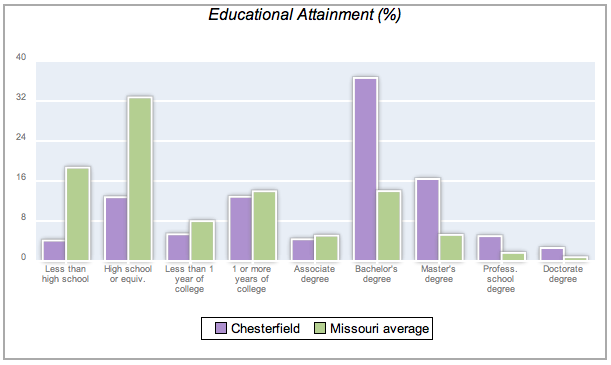
Above: Education attainment in Chesterfield MO.
——————————————————–
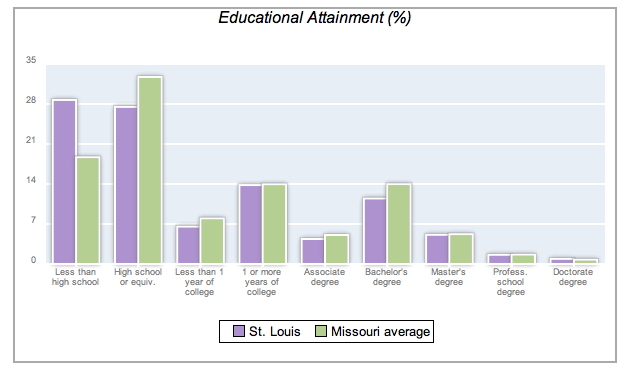
Above. Education attainment in St Louis MO.
——————————————————–
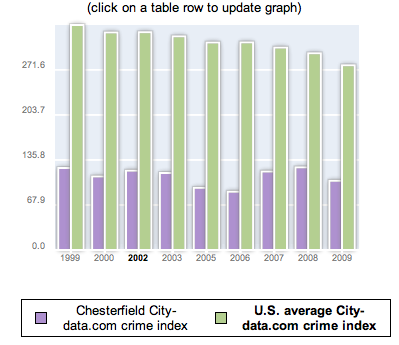
Above: Crime in Chesterfield MO.
——————————————————–
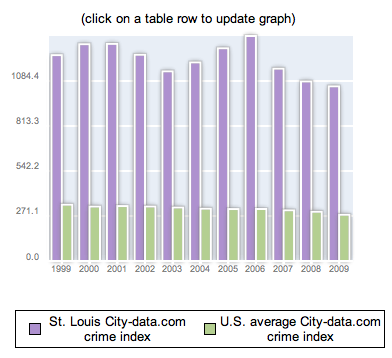
Above: Crime in St Louis MO.
——————————————————–
The city of St Louis tried and failed at luring Centene Corporation out of Chesterfield and into the city. Rawlings, Savvis, Enterprise, Energizer, and other large firms have chosen to remain out west.
This isn’t a trend exclusive to shrinking midsize cities. Chicago, America’s third most populated metropolitan area, struggles with an exodus of major employers. Though Chicago has recently gained Boeing, the number of employees actually working in Boeing’s headquarters in Chicago are few enough to fit into a room. Sears Holdings, known internationally for the Sears Tower in Chicago, left its skyscraper and relocated to Hoffman Estates in 1992.
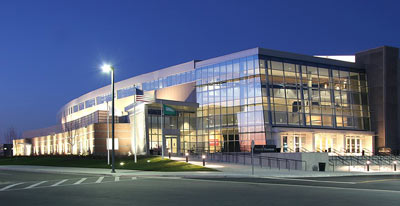
Parking is free in Hoffman Estates.
If people with education and/or professional experience are living in the suburbs, and their employers are moving to the suburbs, wouldn’t that eventually reduce their commute time? Of course, it isn’t that simple. Suburban areas are sprawling in all directions, so someone living in the east side of the metro area may have to drive all the way to the west for work. Wide highways and spider web-shaped interstates have alleviated congestion, but have the unintended consequence of keeping people on the road longer.
There are real problems that come as a consequence of sprawl and deconcentration.
From USA Today, April 2001:
“Wim Wiewel, dean of the College of Business Administration, and Joseph Persky, professor of economics, University of Illinois at Chicago, authors of When Corporations Leave Town, have developed a comprehensive cost-benefit analysis of employment deconcentration, focusing on central cities and their suburbs.”
[..]
“Suburban development, for example, imposes much of its primary cost (such as housing subsidies) on the public sector, with a range of secondary or add-on costs (such as traffic congestion and air pollution) affecting the metropolitan population at large. Yet, the same development offers most of its benefits (such as lower land prices relative to the city and better job opportunities) to the businesses and higher-income households that relocate to the outer suburbs.”
The solution isn’t to raise gas taxes, ban SUVs, inhibit freedom and choice, tax people out of their lifestyles, or end highway development. Cities need to become cleaner, more efficiently run, and more cost-competitive. Responsible management requires discipline, something seriously lacking in major cities. [Mayor Francis Slay of St Louis does deserve some credit for St Louis’s recent comeback, but important projects are bafflingly stalled and buried in conflict and red tape.]
We should have a reasonable discussion on how to address the issue, but I get the feeling that some won’t be satisfied until we’re all living in shoe boxes eating rations of celery, wallowing in misery together.
References:
http://findarticles.com/p/articles/mi_m1272/is_2671_129/ai_73236084/
http://nextstl.com/transportation/less-congestion-more-sprawl-a-lot-more-time-in-the-car-in-st-louis
http://www.city-data.com/city/St.-Louis-Missouri.html
http://www.city-data.com/city/Chesterfield-Missouri.html
St. Louis sounds more and more like a big Spokane the more I read about it. I have a 2 mile commute and live near downtown and I can’t wait to get away from it and out of the city limits, simply because I can’t stand the hideous city government and their continual assault on my freedoms. The roads are so bad and the traffic signals so miss-managed it takes me 15 minutes to drive 2 miles. Then I have to park a quarter mile away from my place of work because the parking is abysmal.
City governments wonder why all the educated, middle class people moved out of town, at the same they hike taxes while providing fewer services. The city of Spokane, for example, hasn’t had normal business hours in their libraries for TEN YEARS due to “budget cuts”. Currently the average library in the city of Spokane is open 24 hours a week. Move out of the city limits and the branches are open 64, yes, sixty-four hours a week, 7 days a week.
If a city can’t even keep libraries open reasonable hours, how can they fair any better in critical areas like education? Spokane’s District 81, which covers all schools in the city limits, has a 29% drop out rate. That’s right, almost one third of all students in the system will never finish high school. Go to the Mead school district, which covers north of Spokane in the county, and the dropout rate is 8.5%!
This is why people move out to the suburbs. Not because gas is cheap or because we somehow enjoy being stuck in traffic for an hour a day. It’s because life is better outside the city!